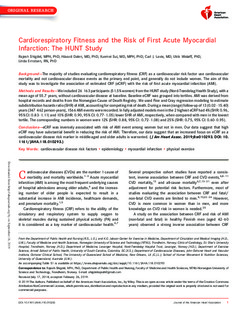| dc.contributor.author | Shigdel, Rajesh | |
| dc.contributor.author | Dalen, Håvard | |
| dc.contributor.author | Sui, Xuemei | |
| dc.contributor.author | Lavie, Carl J. | |
| dc.contributor.author | Wisløff, Ulrik | |
| dc.contributor.author | Ernstsen, Linda | |
| dc.date.accessioned | 2019-09-24T11:37:08Z | |
| dc.date.available | 2019-09-24T11:37:08Z | |
| dc.date.created | 2019-03-06T14:24:12Z | |
| dc.date.issued | 2019 | |
| dc.identifier.citation | Journal of the American Heart Association. 2019, 8 (9) | nb_NO |
| dc.identifier.issn | 2047-9980 | |
| dc.identifier.uri | http://hdl.handle.net/11250/2618486 | |
| dc.description.abstract | Background
The majority of studies evaluating cardiorespiratory fitness (CRF) as a cardiovascular risk factor use cardiovascular mortality and not cardiovascular disease events as the primary end point, and generally do not include women. The aim of this study was to investigate the association of estimated CRF (eCRF) with the risk of first acute myocardial infarction (AMI).
Methods and Results
We included 26 163 participants (51.5% women) from the HUNT study (Nord‐Trøndelag Health Study), with a mean age of 55.7 years, without cardiovascular disease at baseline. Baseline eCRF was grouped into tertiles. AMI was derived from hospital records and deaths from the Norwegian Cause of Death Registry. We used Fine and Gray regression modeling to estimate subdistribution hazards ratio (SHR) of AMI, accounting for competing risk of death. During a mean (range) follow‐up of 13 (0.02–15.40) years (347 462 person‐years), 1566 AMI events were recorded. In fully adjusted models men in the 2 highest eCRF had 4% (SHR: 0.96, 95% CI: 0.83–1.11) and 10% (SHR: 0.90, 95% CI: 0.77–1.05) lower SHR of AMI, respectively, when compared with men in the lowest tertile. The corresponding numbers in women were 12% (SHR: 0.88, 95% CI: 0.72–1.08) and 25% (SHR: 0.75, 95% CI: 0.60–0.95).
Conclusions
eCRF was inversely associated with risk of AMI event among women but not in men. Our data suggest that high eCRF may have substantial benefit in reducing the risk of AMI. Therefore, our data suggest that an increased focus on eCRF as a cardiovascular disease risk marker in middle‐aged and older adults is warranted. | nb_NO |
| dc.language.iso | eng | nb_NO |
| dc.publisher | AHA/ASA Journals | nb_NO |
| dc.relation.uri | https://www.ahajournals.org/doi/full/10.1161/JAHA.118.010293?url_ver=Z39.88-2003&rfr_id=ori:rid:crossref.org&rfr_dat=cr_pub%3dpubmed | |
| dc.rights | Navngivelse-Ikkekommersiell 4.0 Internasjonal | * |
| dc.rights.uri | http://creativecommons.org/licenses/by-nc/4.0/deed.no | * |
| dc.title | Cardiorespiratory Fitness and the Risk of First Acute Myocardial Infarction: The HUNT Study | nb_NO |
| dc.type | Journal article | nb_NO |
| dc.type | Peer reviewed | nb_NO |
| dc.description.version | publishedVersion | nb_NO |
| dc.source.volume | 8 | nb_NO |
| dc.source.journal | Journal of the American Heart Association | nb_NO |
| dc.source.issue | 9 | nb_NO |
| dc.identifier.doi | 10.1161/JAHA.118.010293 | |
| dc.identifier.cristin | 1682627 | |
| dc.description.localcode | Copyright © 2019 The Authors. Published on behalf of the American Heart Association, Inc., by Wiley Blackwell This is an open access article under the terms of the Creative Commons Attribution‐NonCommercial License, which permits use, distribution and reproduction in any medium, provided the original work is properly cited and is not used for commercial purposes. | nb_NO |
| cristin.unitcode | 194,65,20,0 | |
| cristin.unitcode | 1920,6,0,0 | |
| cristin.unitcode | 194,65,25,0 | |
| cristin.unitname | Institutt for samfunnsmedisin og sykepleie | |
| cristin.unitname | Klinikk for hjertemedisin | |
| cristin.unitname | Institutt for sirkulasjon og bildediagnostikk | |
| cristin.ispublished | true | |
| cristin.fulltext | original | |
| cristin.qualitycode | 1 | |

